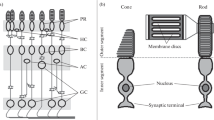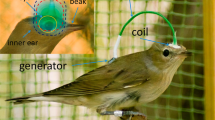Abstract
In many animal species, geomagnetic compass sensitivity has been demonstrated to depend on spectral composition of light to which moving animals are exposed. Besides a loss of magnetic orientation, cases of a shift in the compass direction by 90° following a change in the colour of light have also been described. This hitherto unclear phenomenon can be explained either as a change in motivation or as a side effect of a light-dependent reception mechanism. Among the invertebrates, the 90° shift has only been described in Drosophila. In this paper, another evidence of the phenomenon is reported. Learned compass orientation in the Tenebrio molitor was tested. If animals were trained to remember the magnetic position of a source of shortwave UV light and then tested in a circular arena in diffuse light of the same wavelength, they oriented according to the learned magnetic direction. If, however, they were tested in blue-green light after UV light training, their magnetic orientation shifted by 90° CW. This result is being discussed as one of a few cases of 90° shift reported to date, and as an argument corroborating the hypothesis of a close connection between photoreception and magnetoreception in insects.



Similar content being viewed by others
References
Arikawa K, Wakakuwa M, Qiu X, Kurasawa M, Stavenga DG (2005) Sexual dimorphism of short-wavelength photoreceptors in the small white butterfly, Pieris rapae crucivora. J Neurosci 25:5935–5942
Briscoe A, Chittka L (2001) The evolution of color vision in insects. Annu Rev Entomol 46:471–510
Chittka L, Beier W, Hertel H, Steinmann E, Menzel R (1992) Opponent colour coding is a universal strategy to evaluate the photoreceptor inputs in Hymenoptera. J Comp Physiol 170:545–563
Deutschlander M, Phillips JB, Borland S (1999) The case for light-dependent magnetic orientation in animals. J Exp Biol 202:891–908
Freake MJ, Phillips JB (2005) Light-dependent shift in Bullfrog tadpole magnetic compass orientation: evidence for a common magnetoreception mechanism in anuran and urodele Amphibians. Ethology 111:241–254
Froy O, Gotter AL, Casselman AL, Reppert SM (2003) Illuminating the circadian clock in Monarch butterfly migration. Science 300:1303–1305
Johnsen S, Lohmann KJ (2005) The physics and neurobiology of magnetoreception. Nature Rev Neurosci 6:703–712
Johnsen S, Mattern E, Ritz T (2007) Light-dependent magnetoreception: quantum catches and opponency mechanisms of possible photosensitive molecules. J Exp Biol 210:3171–3178
Kien J, Menzel R (1977) Chromatic properties of interneurons in the optic lobes of the bee. II. Narrow band and colour opponent neurons. J Comp Physiol 113:35–53
Kinoshita M, Pfeiffer K, Homberg U (2007) Spectral properties of identified polarized-light sensitive interneurons in the brain of the Desert locust Schistocerca gregaria. J Exp Biol 210:1350–1361
Kirschfeld K, Hardie R, Lenz G, Vogt K (1988) The Pigment system of the photoreceptor 7-yellow in the fly, a complex photoreceptor. J Comp Physiol 162:421–433
Muheim R, Backman J, Akesson S (2002) Magnetic compass orientation in European robins is dependent on both wavelength and intensity of light. J Exp Biol 205:3845–3856
Osorio D (1986) Ultraviolet sensitivity and spectral opponency in the locust. J Exp Biol 122:193–208
Phillips JB, Borland C (1992) Magnetic compass orientation is eliminated under near-infrared light in the Eastern red-spotted newt Notophthalmus viridescens. Anim Behav 44:796–797
Phillips JB, Sayeed O (1993) Wavelength-dependent effects of light on magnetic compass orientation in Drosophila melanogaster. J Comp Physiol 172:303–308
Ritz T, Adem S, Schulten K (2000) A model for photoreceptor-based magnetoreception in birds. Biophys J 78:707–718
Ritz T, Dommer DH, Phillips JB (2002) Shedding light on vertebrate magnetoreception. Neuron 34:503–506
Sauman I, Briscoe AD, Zhu HS, Shi DD, Froy O, Stalleicken J, Yuan Q, Casselman A, Reppert SM (2005) Connecting the navigational clock to sun compass input in Monarch butterfly brain. Neuron 46:457–467
Vácha M, Soukopová H (2004) Magnetic orientation in the mealworm beetle Tenebrio and the effect of light. J Exp Biol 207:1241–1248
Wang K, Mattern E, Ritz T (2006) On the use of magnets to disrupt the physiological compass of birds. Phys Biol 3:220–231
Wiltschko R, Wiltschko W (1995) Magnetic orienation in animals. Springer, Heidelberg, p 297
Wiltschko W, Wiltschko R (2005) Magnetic orientation and magnetoreception in birds and other animals. J Comp Physiol 191:675–693
Wiltschko R, Wiltschko W (2006) Magnetoreception. bioessays 28:157–168
Zhu H, Sauman I, Yuan Q, Casselman A, Emery-Le M, Emery P, Reppert SM (2008) Cryptochromes define a novel circadian clock mechanism in Monarch butterflies that may underlie sun compass navigation. PLoS Biology 6:e4
Acknowledgments
This research was supported by a grant from the Czech Science Foundation (GACR 206/07/J041, 206/05/0911) and from the Ministry of Education, Youth and Sports (MSM 0021622416). The research was conducted according to all applicable laws of animal welfare.
Author information
Authors and Affiliations
Corresponding author
Rights and permissions
About this article
Cite this article
Vácha, M., Půžová, T. & Drštková, D. Effect of light wavelength spectrum on magnetic compass orientation in Tenebrio molitor . J Comp Physiol A 194, 853–859 (2008). https://doi.org/10.1007/s00359-008-0356-9
Received:
Revised:
Accepted:
Published:
Issue Date:
DOI: https://doi.org/10.1007/s00359-008-0356-9




